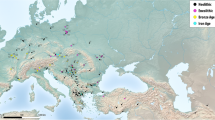Abstract.
At the end of the 6th millennium B. C. Triticum monococcum (einkorn) and Triticum dicoccum (emmer) were the main cereals of the early Neolithic Bandkeramik culture in central Europe. New archaeobotanical investigations at relevant Bandkeramik sites reveal the regular occurrence of morphologically two-grained einkorn. Some preliminary thoughts on the state of research and the possible origin of two-grained einkorn forms are presented here.
Similar content being viewed by others
Author information
Authors and Affiliations
Additional information
Received January 7, 2002 / Accepted August 5, 2002
Correspondence to: Angela Kreuz
Rights and permissions
About this article
Cite this article
Kreuz, A., Boenke, N. The presence of two-grained einkorn at the time of the Bandkeramik culture. Veget Hist Archaeobot 11, 233–240 (2002). https://doi.org/10.1007/s003340200026
Issue Date:
DOI: https://doi.org/10.1007/s003340200026



